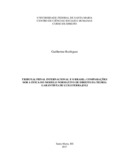| dc.contributor.advisor | Schorr, Janaína Soares | |
| dc.creator | Rodrigues, Guilherme | |
| dc.date.accessioned | 2017-08-25T16:07:41Z | |
| dc.date.available | 2017-08-25T16:07:41Z | |
| dc.date.issued | 2017-07-10 | |
| dc.date.submitted | 2017 | |
| dc.identifier.uri | http://repositorio.ufsm.br/handle/1/11572 | |
| dc.description | Trabalho de conclusão de curso (graduação) - Universidade Federal de Santa Maria, Centro de Ciências Sociais e Humanas, Curso de Direito, RS, 2017. | por |
| dc.description.abstract | The present monograph has the intention of to analyze the structure of the International Criminal Court under the vision of the Guarantees Theory of Luigi Ferrajoli, in comparison with brazilian penal structure. Therefore, it will use the deductive approach method and the comparative-tipologic proceeding method. This one will be done through a first approach about the structure and creation of the Court, and its incorporation to the brazilian and international law, then heading on the second chapter to the explanation of the guarantist theory, to explain the parameters of the comparison. On the third and last chapter, it will be made a comparison with the brazilian jurisdiction structure, making some notes about the more critical points. The approach will be done with the intention of deduce on the last chapter starting by the introduced on the two first chapters. With this, it will be tried to define a better approximation/distance of the idealized model. The search technique will be bibliographic, and will have base in the Federal Brazilian Constitution and its ordinary legislation, as well as the Rome Statute e its respective Court Regulation. The comparison of the structures will be done exclusively about the normative basis because the analysis will be restricted to the law normative model, on account of the necessity of a thematic incision. Because of this, the work will be dedicated only to the elements of the Procedural Criminal Law, without attack the material law. The importance of the present approach is because of the recent inauguration of an international penal jurisdiction scenery that includes multifaceted models of penal persecution. In function thereof is the complexity of the review, it tries to understand the effectiveness of this sui generis institution on the pursuit of the penal responsibility in international level, and by the legitimate form, not offending the indicted guarantees, and to compare it to the brazilian structure . | eng |
| dc.language | por | por |
| dc.publisher | Universidade Federal de Santa Maria | por |
| dc.rights | Acesso Aberto | por |
| dc.subject | Direito penal | por |
| dc.subject | Direito processual penal | por |
| dc.subject | Tribunal Penal Internacional | por |
| dc.subject | Sistema penal brasileiro | por |
| dc.subject | Teoria das garantias | por |
| dc.subject | Garantias penais | por |
| dc.subject | Luigi Ferrajoli | por |
| dc.subject | Criminal law | eng |
| dc.subject | Criminal procedure law | eng |
| dc.subject | International Criminal Court | eng |
| dc.subject | Brazilian criminal system | eng |
| dc.subject | Guarantees theory | eng |
| dc.subject | Criminal guarantees | eng |
| dc.title | Tribunal Penal Internacional e o Brasil: comparações sob a ótica do modelo normativo de direito da teoria garantista de Luigi Ferrajoli | por |
| dc.title.alternative | International Criminal Court and Brazil: comparations under the vision of law normatives model of the guarantees theory of Luigi Ferrajoli | eng |
| dc.type | Trabalho de Conclusão de Curso de Graduação | por |
| dc.degree.local | Santa Maria, RS, Brasil | por |
| dc.degree.graduation | Direito | por |
| dc.description.resumo | A presente monografia tem o intuito de analisar a estrutura do Tribunal Penal Internacional,
sob a ótica de Teoria do Garantismo de Luigi Ferrajoli, em comparação com a estrutura penal
brasileira. Para tanto, utilizar-se-á o método de abordagem dedutivo e o método de
procedimento comparativo-tipológico. Este se dará através de uma primeira abordagem
referente à estrutura e criação do Tribunal, assim como sua incorporação ao direito brasileiro e
internacional, partindo-se no segundo capítulo para a explanação da teoria garantista, a fim de
explicitar os parâmetros de comparação. No terceiro e último capítulo, enfim será realizado
um comparativo com a estrutura da jurisdição penal brasileira, tecendo apontamentos em
relação aos pontos mais críticos. A abordagem dar-se-á com fim de deduzir no último capítulo,
a partir do apresentado nos dois primeiros. Com isso, intenta-se definir a maior
aproximação/afastamento do modelo idealizado. A técnica de pesquisa utilizada será a
bibliográfica, e terá como base a Constituição Federal Brasileira e a legislação ordinária
brasileira, assim como o Estatuto de Roma e suas respectivas Regras de Procedimento e Prova.
A comparação das estruturas ocorrerá exclusivamente em relação às bases normativas, pois a
análise restringir-se-á ao modelo normativo de direito, por necessidade de corte temático.
Também por este motivo o trabalho se dedicará aos elementos do direito processual penal,
sem transpassar ao direito material. A importância da presente abordagem se dá em vista da
inauguração de um recente patamar de jurisdição internacional penal, que abrange
multifacetados modelos de persecução penal. Daí a complexidade do estudo, que busca
entender a eficácia dessa instituição sui generis na busca da responsabilização penal, em nível
mundial e de forma legítima, sem ofender às garantias do acusado, e compará-la ao patamar
brasileiro. | por |
| dc.publisher.country | Brasil | por |
| dc.publisher.initials | UFSM | por |
| dc.subject.cnpq | CNPQ::CIENCIAS SOCIAIS APLICADAS::DIREITO | por |
| dc.publisher.unidade | Centro de Ciências Sociais e Humanas | por |


